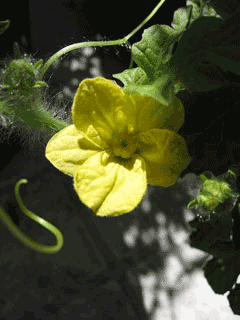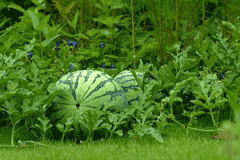 |
|
|
 |
| http://www.flickr.com/photos/93965446@N00 |
Translate this page:
Summary
Physical Characteristics

 Citrullus lanatus is a ANNUAL growing to 0.5 m (1ft 8in) by 2 m (6ft).
Citrullus lanatus is a ANNUAL growing to 0.5 m (1ft 8in) by 2 m (6ft).
See above for USDA hardiness. It is hardy to UK zone 9 and is frost tender. It is in flower from July to August. The species is monoecious (individual flowers are either male or female, but both sexes can be found on the same plant) and is pollinated by Insects. The plant is self-fertile.
Suitable for: light (sandy) and medium (loamy) soils and prefers well-drained soil. Suitable pH: mildly acid, neutral and basic (mildly alkaline) soils. It cannot grow in the shade. It prefers dry or moist soil and can tolerate drought.
UK Hardiness Map
US Hardiness Map
Synonyms
C. vulgaris.
Plant Habitats
Cultivated Beds;
Edible Uses
Edible Parts: Fruit Leaves Oil Oil Seed
Edible Uses: Oil Oil Pectin
Fruit - raw. A very refreshing fruit[1, 2, 22, 46, 183], it has a delicate sweetness with an extremely high water content, the fruit is often used as a refreshing drink[183]. The unripe fruits are added to soups[183]. A syrup can also be made from the juice[183]. The fruit is a rich source of pectin[218, 240], and can be added to pectin-low fruits when making jam[K]. Pectin is said to protect the body against radiation[201]. The fruit varies considerably in size from cultivar to cultivar, but can be up to 1 metre long and 40cm wide[200]. A nutritional analysis is available[218]. Leaves - cooked. Seed - raw or cooked[63, 86, 117, 183]. They can be roasted or ground into a powder and used with cereal flours when making bread, cakes etc, or added to soups and stews[163, 105, 83]. The seed contains about 30% protein, 20 - 40% oil[61]. An edible oil is obtained from the seed[63, 105, 183, 266].
References More on Edible Uses
| Composition
|
| Figures in grams (g) or miligrams (mg) per 100g of food.
|
|
|
Fruit (Dry weight)
|
|
- 344 Calories per 100g
- Water : 0%
- Protein: 7.8g; Fat: 1.6g; Carbohydrate: 85.9g; Fibre: 6.3g; Ash: 4.7g;
- Minerals - Calcium: 125mg; Phosphorus: 141mg; Iron: 4.7mg; Magnesium: 0mg; Sodium: 0mg; Potassium: 1351mg; Zinc: 0mg;
- Vitamins - A: 4300mg; Thiamine (B1): 0.5mg; Riboflavin (B2): 0.6mg; Niacin: 0mg; B6: 0mg; C: 0mg;
- Reference: [ 218]
- Notes:
|
|
Medicinal Uses
Plants For A Future can not take any responsibility for any adverse effects from the use of plants. Always seek advice from a professional before using a plant medicinally.
Cardiac Demulcent Diuretic Enuresis Febrifuge Pectoral Purgative Tonic
Urinary Vermifuge
The seed is demulcent, diuretic, pectoral and tonic[4, 218]. It is sometimes used in the treatment of the urinary passages[4] and has been used to treat bed wetting[257]. The seed is also a good vermifuge[4] and has a hypotensive action[7]. A fatty oil in the seed, as well as aqueous or alcoholic extracts, paralyze tapeworms and roundworms[240]. The fruit, eaten when fully ripe or even when almost putrid, is used as a febrifuge[4] The fruit is also diuretic, being effective in the treatment of dropsy and renal stones[7]. The fruit contains the substance lycopine (which is also found in the skins of tomatoes). This substance has been shown to protect the body from heart attacks and, in the case of the tomato at least, is more effective when it is cooked[246]. The rind of the fruit is prescribed in cases of alcoholic poisoning and diabetes[218]. The root is purgative and in large dose is said to be a certain emetic[4].
References More on Medicinal Uses
The Bookshop: Edible Plant Books
Our Latest books on Perennial Plants For Food Forests and Permaculture Gardens in paperback or digital formats.

Edible Tropical Plants
Food Forest Plants for Hotter Conditions: 250+ Plants For Tropical Food Forests & Permaculture Gardens.
More

Edible Temperate Plants
Plants for Your Food Forest: 500 Plants for Temperate Food Forests & Permaculture Gardens.
More

More Books
PFAF have eight books available in paperback and digital formats. Browse the shop for more information.
Shop Now
Other Uses
Oil Oil Pectin
The seed contains 20 - 40% oil. As well as being edible, it is also used for making soap and for lighting[117]. Face masks made from the fruit are used as a cosmetic on delicate skins[7].
Special Uses
References More on Other Uses
Cultivation details
Prefers a rich sandy loam and a very sunny position[1, 117, 200]. A drought resistant plant once established, it is intolerant of wet soils[117]. Tolerates a pH in the range 5.3 to 8. The water melon is frequently grown for its edible fruit in warm temperate and tropical areas, there are many named varieties[183]. It is not frost hardy and requires a long hot summer if it is to fruit well. It is not really a suitable crop for growing outdoors in Britain at the present time, though it is possible that new faster maturing cultivars will be developed. It is best grown in greenhouse conditions in Britain[K]. The cultivars 'Fordbrook hybrid', New Hampshire midget' and 'Sugar baby' mature in 80 - 85 days in Long Island, New York[200]. A good companion plant for potatoes[20].
References Carbon Farming Information and Carbon Sequestration Information
Temperature Converter
Type a value in the Celsius field to convert the value to Fahrenheit:
Fahrenheit:
The PFAF Bookshop
Plants For A Future have a number of books available in paperback and digital form. Book titles include Edible Plants, Edible Perennials, Edible Trees,Edible Shrubs, Woodland Gardening, and Temperate Food Forest Plants. Our new book is Food Forest Plants For Hotter Conditions (Tropical and Sub-Tropical).
Shop Now
Plant Propagation
Seed - sow spring in a rich compost in a greenhouse. Either put 2-3 seeds in each pot and thin to the best plant, or prick out the seedlings into individual pots of rich soil as soon as they are large enough to handle. Grow them on fast and, if trying them outside, plant out after the last expected frosts. Give them some protection, such as a cloche or a frame, at least until they are growing away vigorously.
Other Names
If available other names are mentioned here
Native Range
AFRICA: Egypt (south), Sudan, Kenya (north).
Weed Potential
Right plant wrong place. We are currently updating this section.
Please note that a plant may be invasive in one area but may not in your area so it's worth checking.
Conservation Status
IUCN Red List of Threatened Plants Status :

Growth: S = slow M = medium F = fast. Soil: L = light (sandy) M = medium H = heavy (clay). pH: A = acid N = neutral B = basic (alkaline). Shade: F = full shade S = semi-shade N = no shade. Moisture: D = dry M = Moist We = wet Wa = water.
Now available:
Food Forest Plants for Mediterranean Conditions
350+ Perennial Plants For Mediterranean and Drier Food Forests and Permaculture Gardens.
[Paperback and eBook]
This is the third in Plants For A Future's series of plant guides for food forests tailored to
specific climate zones. Following volumes on temperate and tropical ecosystems, this book focuses
on species suited to Mediterranean conditions—regions with hot, dry summers and cool, wet winters,
often facing the added challenge of climate change.
Read More
Expert comment
Author
(Thunb.)Matsum.&Nakai.
Botanical References
200266
Links / References
For a list of references used on this page please go here
Readers comment
© 2010, Plants For A Future. Plants For A Future is a charitable company limited by guarantee, registered in England and Wales. Charity No. 1057719, Company No. 3204567.